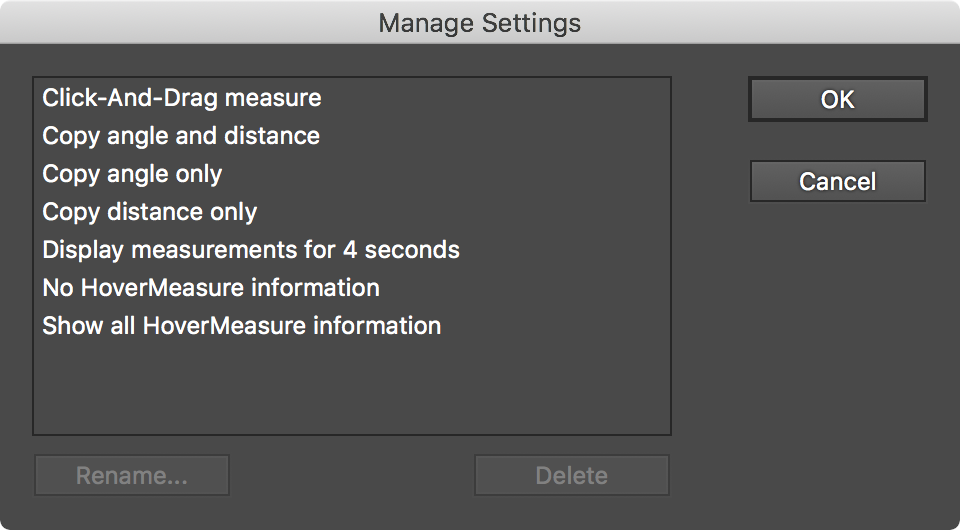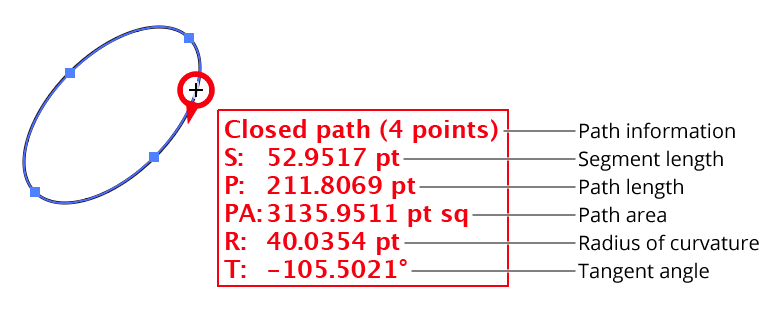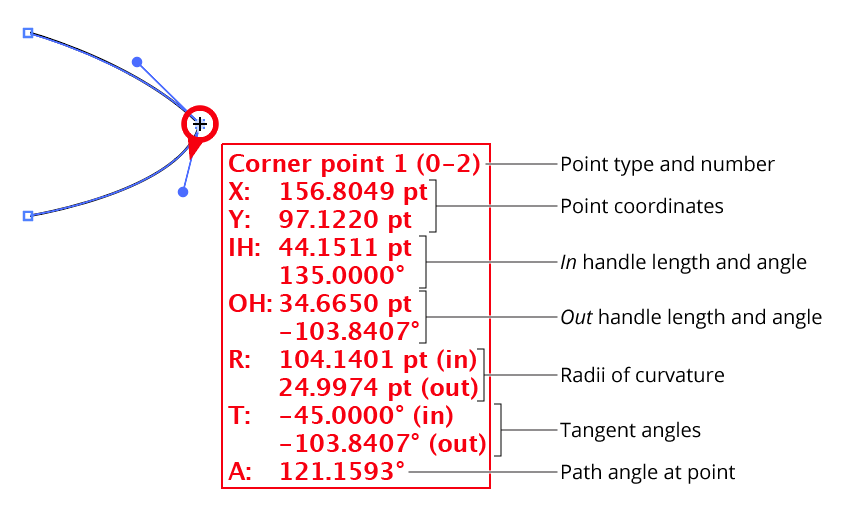 Dynamic Measure Preferences
Dynamic Measure Preferences
The Dynamic Measure preferences dialog can be brought up in three ways: by choosing Dynamic Measure Preferences... in the flyout menu of the panel; by double-clicking on the Dynamic Measure tool icon in the toolbar; or by pressing the Return/Enter key when the Dynamic Measure tool is selected.
The preference dialog has four sections (General, Highlighting, On-Screen Display, and HoverMeasure) which can be accessed using the popup menu at top or the “Previous” and “Next” buttons at right.

Dynamic Measure Preferences (General)
1. Mode Setting
The default, two-click mode, is more powerful because you can zoom or scroll the document or even change these preference settings while in the middle of a measure.
2. Precision
Specifies how many digits with which to display values.
3. Measure Color Setting
Specifies the color in which Dynamic Measure’s line annotation is drawn (red or black).
4. Show Measure Direction Indicator
When enabled (the default), a small arrowhead in the the center of the measure indicates the direction in which the measure was made.
5. Copy Angle to Constrain Angle Preference
6. Always / Use Option/Alt Key Rotation
When enabled, the measured angle is copied to the Illustrator general “Constrain Angle” preference upon completion of the measure. A small angle icon appears next to the cursor to indicate that this copying will take place. You can have this option always enabled, or use the Option/Alt key to toggle it on and off.
7. Copy Distance to Keyboard Increment Preference
8. Always / Use Option/Alt Key Rotation
When enabled, the measured distance is copied to the Illustrator general “Keyboard Increment” preference upon completion of the measure. A small ruler icon appears next to the cursor to indicate that this copying will take place. You can have this option always enabled, or use the Option/Alt key to toggle it on and off.
9. Require Shift with Option/Alt for Angle/Distance Rotation
Because the Option/Alt key is also used for other things – e.g. in the keystroke for temporarily selecting the zoom-out magnifying glass – you may want to enable this preference so that you must press Shift at the same time as Option/Alt to rotate through the settings. Note that if you do this while in the middle of a measure, the measure line may momentarily jump while it is being constrained.
When HoverMeasure is enabled and Show Curve Normals or Show Point Normals are enabled, the Shift key and Option/Alt keys are used to control its functions when hovering over a path. To rotate through the Copy... preferences in this case, temporarily move away from the path. Likewise, because deleting or moving a measure use Shift and Option/Alt, these keys will not rotate the Copy preferences while over measure data or a measure’s endpoint.
10. Reset Distance/Angle Prefs on Shift+Tool Selection
Allows resetting of the Constrain Angle and Keyboard Increment preferences to their default values (1
pt and 0°) by holding down Shift and selecting the Dynamic Measure tool from the tool panel. You don’t actually need to make a measurement after doing this. Note: The Dynamic Measure tool must not already selected.
11. Default Font
12. Font Size
Specifies the font and its size that are used by default when converting a Dynamic Measure to artwork. Once the first measure has been converted in a document, all converted measures use the “Dynamic Measure” Paragraph Style, which can be edited as usual.
13. Line Weight
Specifies the weight of the line that is created by default when converting a Dynamic Measure to artwork. Once the first measure has been converted in a document, all converted measures use the “Dynamic Measure” Graphic Style, which can be edited as usual.
14. No Hardwired Arrowheads
When enabled, arrowheads are not drawn on the ends of converted measures with additional lines. Instead, you can edit the “Dynamic Measure” Graphic Style to add arrowheads via the Stroke panel.
15. Layer Is Initially Unlocked
When enabled, the layer into which converted Dynamic Measures are placed is left unlocked so they may be immediately edited.
16. Settings Manager

Dynamic Corners Preferences setting manager menu option
The Settings Manager popup menu provides access to saving, managing, and applying preference settings.
A. Save Settings...
When you save the preference settings, all of the current settings in the preferences dialog are captured in a file which can be recalled later.
B. Manage Settings...
Brings up the Manage Settings dialog, which lets you rename or delete existing settings files:

Dynamic Corners Preferences manage settings
C. Settings List
Choosing a settings file from this list will change the preference settings to match the state of the panel when the settings file was saved (or, the case of “[Default]”, to the default values). Dynamic Measure comes with several simple pre-made settings files.

Dynamic Measure Preferences (Highlighting)
17. Highlight Cursor When Snapping With Smart Guides
Displays the cursor highlighting ring when Smart Guides are enabled, for extra visibility and to indicate the snapping status of the start point after the cursor has been moved away.
18. Highlight Cursor And Snap Without Smart Guides
19. On Path Segments Too
Causes the cursor to snap to anchor points and handles (and display the snapping ring) when Smart Guides are disabled. When On Path Segments Too is enabled, snapping will also happen to path segments and guides.
20. Snapping Ring Style
Lets you choose between four different styles of snapping rings.
21. Show Path Direction Arrows
22. Keep Arrows After Measure Only When Distance Along Path was Measured
When enabled (the default), red path direction arrowheads appear next to the cursor when it is over an unlocked path, to show you in which direction the path winds. This is most useful when measuring distance along a path, because on a closed path there are two distances along the path: one With the path direction and one Against. If you’re showing dimensional measurements after a measure, any path direction arrows will remain too. However, you can choose to show them after the measure is complete only if a distance along path measurement was taken.

Dynamic Measure Preferences (On-Screen Display)
23. Show Dimensional Measurements in Document Window
Displays the measurements as annotations near the measure (as opposed to only in the Information panel).
24. Mode Selection
In Continuous mode, values are displayed while the measure is in progress, but not afterwards (thus measures are never retained). The default mode is Both, which displays value during and after the measure.
25. Keep last __ measures
Specifies the number of measures to retain (up to a maximum of 50). For example, if you enter 10, then the last ten measures will stay on the screen. If you then make an eleventh measure, it will replace the first (oldest) measure. You can keep up to the last 50 measures; the default value is 25.
26. Retention Time
Specifies how long the measurements will remain on the screen: indefinitely (the default), or between 1 and 99 seconds.
27. Show Measurements When Tool is Deselected
Controls whether the measurements remain visible on the screen when you deselect the Dynamic Measure tool. The default is to remain.
28. Style Selection
Allows you to specify the style of the measurement values. When a setting is changed, the preview area below will update to show the new style. When Use Delta Symbol is disabled, the a lowercase “d” is used instead.
29. Positioning
Endpoint puts the measurements above and to the right of the endpoint of the measure (which, during an active measure, is the same as the cursor position). If two measures end at the same spot, however, their data will overlap. You can therefore choose Centered to place the measurements at the center of the measure line (above or below, depending on the angle of the measure). The third option, Endpoint, then Centered (which is the default), places the measurements by the cursor during an active measure but moves them to the center of the measure line afterwards.
30. Positioning
Previews what a measure will look like with the chosen Style and Position settings.

Dynamic Measure Preferences (HoverMeasure)
31. Enable HoverMeasure
Enables or Disable all HoverMeasure items (see Dynamic Measure Tool: HoverMeasure).
32. Show Path Information
Shows the type of path (open or closed) and the number of anchor points it contains.
33. Show Segment Length
34. Show Path Length
Shows the length (as measured along the curves of the path) of the segment (prefixed by “S:”) and the path (prefixed by “P:”).
35. Show Path Area
Shows the area of the path (prefixed by “PA:”). Open paths are treated as if there were a straight segment connecting the endpoints. Subpaths of compound paths are treated independently, so to measure the area of a donut, say, you must subtract the area of the inner path from the area of the outer path. Paths with self-intersections are not valid for measuring area; it may be possible to use the PathFinder Unite function to split it into multiple non-self-intersecting paths and measure their areas separately.
36. Show Radius of Curvature
Shows the radius of curvature at a spot along the path (prefixed by “R:”).
37. Show Tangent Angle
Shows the angle of a straight line tangent to the path at that spot (prefixed by “T:”).

Dynamic Measure example show tangent angle
38. Show Curve Normal(s) with Option-Alt/Shift
39. Divisions
When Option/Alt is pressed (Shift may be added), divides the bezier segment into the specified number of sections (from 2 to 1000) and draws a straight line normal (perpendicular) to the path at each spot, with a length equal to the radius of curvature. Lines are not drawn if the radius of curvature is infinite (such as on a straight line). See Dynamic Measure Tool: Curve Normals.
40. Show Point Type
Shows the type of anchor point (Corner or Smooth).
41. Show Point Number
Shows the index of the anchor point (which starts at zero and increases in the direction of the path), and the range of indices in the entire path.
42. Show Point Coordinates
Shows the X and Y coordinates of the anchor point.
43. Show Handle Information
Shows the length and angles of the handle(s) for the anchor point. “IH:” prefixes the In handle data, and “OH:” prefixes the Out handle data.
44. Show Radius/ii of Curvature
Shows the radius/ii of Curvature of the path as it passes through the anchor point, prefixed with “R:”. If the radii are different between the segment on the in side of the point and the segment on the out side (such as with corner points), then both values are shown, with “(in)” and “(out)” appended to distinguish them.
45. Show Tangent Angle(s)
Shows the angle of a straight line that is tangent to the path as it passes through the anchor point, prefixed with “T:”. If the angles are different between the segment on the in side of the point and the segment on the out side (such as with corner points), then both values are shown, with “(in)” and “(out)” appended to distinguish them.
46. Show Path Angle at Point
Shows the angle between the segment as it enters the anchor point and the segment as it leaves the anchor point. It is indicated by “A:” and is not displayed for endpoints. The corner points of a rectangle, for example, will all have path angles of 90°. Smooth points will always have an angles of 180°.

Dynamic Measure point information
47. Show Point Normal(s) with Option-Alt/Shift
Similar to its counterpart Show Curve Normal(s), except that both Option/Alt and Shift do the same thing.
48. Show Handle Coordinates
Shows the X and Y coordinates of the handle.
49. Show Handle Length
Shows length of the handle.
50. Show Handle Angle
Shows angle of the handle.

Dynamic Measure Show Handle Information
51. Help Button
Opens the help documentation in the Astute Manager. If this does not automatically appear, please ensure your Astute Manager is running first.
